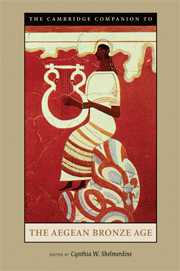Book contents
- Frontmatter
- 1 Background, Sources, and Methods
- 2 The Early Bronze Age in Greece
- 3 The Early Bronze Age in the Cyclades
- 4 Early Prepalatial Crete
- 5 Protopalatial Crete
- 6 The Material Culture of Neopalatial Crete
- 7 Minoan Culture: Religion, Burial Customs, and Administration
- 8 Minoan Crete and the Aegean Islands
- 9 Minoan Trade
- 10 Early Mycenaean Greece
- 11 Mycenaean Art and Architecture
- 12 Mycenaean States
- 13 Burial Customs and Religion
- 14 Mycenaean Greece, the Aegean and Beyond
- 15 Decline, Destruction, Aftermath
- Glossary
- Select Bibliography
- Index
- Plate section
4 - Early Prepalatial Crete
Published online by Cambridge University Press: 28 November 2010
- Frontmatter
- 1 Background, Sources, and Methods
- 2 The Early Bronze Age in Greece
- 3 The Early Bronze Age in the Cyclades
- 4 Early Prepalatial Crete
- 5 Protopalatial Crete
- 6 The Material Culture of Neopalatial Crete
- 7 Minoan Culture: Religion, Burial Customs, and Administration
- 8 Minoan Crete and the Aegean Islands
- 9 Minoan Trade
- 10 Early Mycenaean Greece
- 11 Mycenaean Art and Architecture
- 12 Mycenaean States
- 13 Burial Customs and Religion
- 14 Mycenaean Greece, the Aegean and Beyond
- 15 Decline, Destruction, Aftermath
- Glossary
- Select Bibliography
- Index
- Plate section
Summary
Crete is by far the largest of the Greek islands (ca. 8,200 sq. km), about 250 km west-east and 57 km north-south at its widest point in the center; this makes it over three times the entire land mass of the Cycladic islands. The topography of the island divides it into five main regions, each defined by a mountain range, extensive arable - usually coastal - plain, and good harborage.
Western Crete – The White Mountains (highest point at 2,453 m) limit settlement to the long north coastal plain, with Early Minoan sites of note at Nopigeia and Chania, the funerary (?) caves of Perivolia and Platyvola, and the “shepherds’ compound” at Debla.
Rethymnon – This region on the north coast is roughly equidistant between west and central Crete. The major coastal settlement was at Stavromenos, from which an overland route leads south to the Mesara via the Amari valley. Throughout the Minoan period this route would foster cultural links between the two areas.
North-Central Crete – The center of the island is dominated by the Idaean mountain range (peak at 2,465 m) that separates the north coastal plain of Herakleion from the Mesara in the south. In the midst of this range is the Idaean cave, which may have had the longest period of sacred use on Crete, from Neolithic through Roman times. Human settlement on the island began in this region, marked by the aceramic Neolithic levels at Knossos. Five km north of Knossos, at the mouth of the Kairatos River, was the principal Neolithic and Bronze Age port for this area at Poros–Katsambas (Herakleion). South of Knossos was the important Minoan settlement at Archanes and the nearby cemetery at Phournoi. A number of overland routes connected the north coast with the Mesara Plain in the south.
…
- Type
- Chapter
- Information
- The Cambridge Companion to the Aegean Bronze Age , pp. 77 - 104Publisher: Cambridge University PressPrint publication year: 2008
- 13
- Cited by



